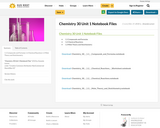
1.1 Compounds and Formulas
1.2 Chemical Reactions
1.3 Mole Theory and Stoichiometry
- Subject:
- Chemistry
- Science
- Material Type:
- Activity/Lab
- Unit of Study
- Date Added:
- 10/17/2018

1.1 Compounds and Formulas
1.2 Chemical Reactions
1.3 Mole Theory and Stoichiometry
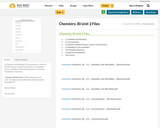
2.1 Solubility and Miscibility
2.2 Concentration
2.3 Dilution, Standard Solution, and Ion Concentrations
2.4 Solubility Curves and Tables
2.5 Precipitate Reactions
2.6 Selective Precipitation
Unit 2 Exam

2.1 Solubility and Miscibility
2.2 Concentration
2.3 Dilution, Standard Solutions and Ion Concentration
2.4 Solubility Curves and Tables
2.5 Precipitate Reactions
2.6 Selective Precipitation
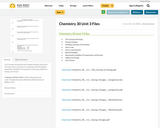
The Concept of Energy
Energy Changes
Enthalpy and Heat of Formation
Hess's Law
Hess's Law Equation
Bond Enthalpies
Spontaneity, Stability of Compounds, and Entropy
Gibbs Free Energy
Unit 3 Exam

The Concept of Energy
Energy Changes
Enthalpy and Heat of Formation
Hess's Law
Hess's Law Equation
Bond Enthalpies
Spontaneity, Stability of Compounds, and Entropy
Gibbs Free Energy
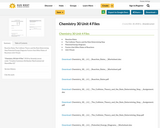
Reaction Rates
The Collision Theory and the Rate Determining Step
Potential Energy Diagrams
Factors that Affect Rates of Reactions
Unit 4 Exam
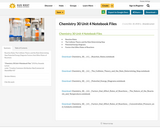
Reaction Rates
The Collision Theory and the Rate Determining Step
Potential Energy Diagrams
Factors that Affect Rates of Reactions
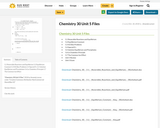
5.1 Reversible Reactions and Equilibrium
5.2 Equilibrium Constant
5.3 ICE Box Problems
5.4 Special K's
5.5 Solution Equilibrium and Precipitates
5.6 Le Chateliers Principle
5.7 The Common Ion Effect
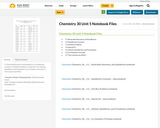
5.1 Reversible Reactions and Equilibrium
5.2 Equilibrium Constant
5.3 ICE Box Problems
5.4 Special K's
5.5 Solution Equilibrium and Precipitates
5.6 Le Chateliers Principle
5.7 The Common Ion Effect
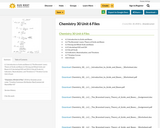
6.1 Introduction to Acids and Bases
6.2 The Bronsted- Lowry Theory of Acids and Bases
6.3 Strong and Weak Acids and Bases
6.4 Calculating H3O and OH
6.5 the pH Scale
6.6 Indicators, Neutralization, and Titrations
6.7 Titration Curves
Unit 6 Exam
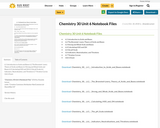
6.1 Introduction to Acids and Bases
6.2 The Bronsted- Lowry Theory of Acids and Bases
6.3 Strong and Weak Acids and Bases
6.4 Calculating H3O and OH
6.5 the pH Scale
6.6 Indicators, Neutralization, and Titrations
6.7 Titration Curves
Unit 6 Exam
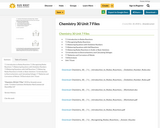
7.1 Introduction to Redox Reactions
7.2 Recognizing Redox Reactions
7.3 Balancing Equations with Oxidation Numbers
7.4 Balancing Equations with Half Reactions
7.5 Balancing Redox Reactions in Acidic or Basic Solutions
7.6 Introduction to Electrochemistry and Calculating Voltages
7.7 Batteries and Corrosions of Metals
7.8 Electrolysis
Unit 7 Exam
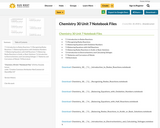
7.1 Introduction to Redox Reactions
7.2 Recognizing Redox Reactions
7.3 Balancing Equations with Oxidation Numbers
7.4 Balancing Equations with Half Reactions
7.5 Balancing Redox Reactions in Acidic or Basic Solutions
7.6 Introduction to Electrochemistry and Calculating Voltages
7.7 Batteries and Corrosions of Metals
7.8 Electrolysis

Chemistry: Atoms First is a peer-reviewed, openly licensed introductory textbook produced through a collaborative publishing partnership between OpenStax and the University of Connecticut and UConn Undergraduate Student Government Association.
This title is an adaptation of the OpenStax Chemistry text and covers scope and sequence requirements of the two-semester general chemistry course. Reordered to fit an atoms first approach, this title introduces atomic and molecular structure much earlier than the traditional approach, delaying the introduction of more abstract material so students have time to acclimate to the study of chemistry. Chemistry: Atoms First also provides a basis for understanding the application of quantitative principles to the chemistry that underlies the entire course.

This 10-minute video lesson discusses Carbon 14 Dating (1). [Chemistry playlist: Lesson 105 of 106].

This 10-minute video lesson discusses Carbon 14 Dating (2). [Chemistry playlist: Lesson 106 of 106].

This collection of videos, animations and documents comes from the NCSSM AP chemistry online course. Chapter ten provides practice and demonstrations related to intermolecular forces in chemistry.

This collection of videos, animations and documents comes from the NCSSM AP chemistry online course. Chapter eleven provides practice and demonstrations related to thermochemistry.

This collection of videos, animations and documents comes from the NCSSM AP chemistry online course. Chapter twelve provides practice and demonstrations related to colligative properties in chemistry.

This collection of videos, animations and documents comes from the NCSSM AP chemistry online course. Chapter thirteen provides practice and demonstrations related to thermodynamics in chemistry.